数理经济学1
- 格式:pdf
- 大小:157.01 KB
- 文档页数:16

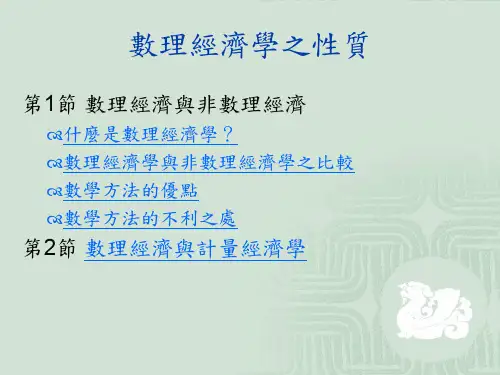
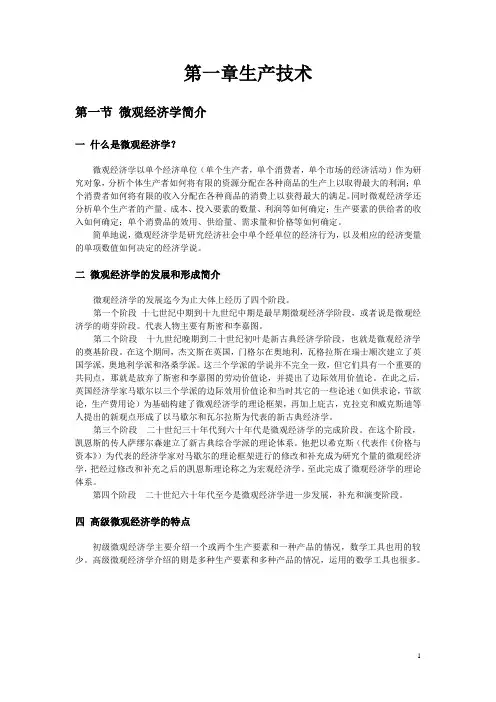
第一章生产技术第一节微观经济学简介一什么是微观经济学?微观经济学以单个经济单位(单个生产者,单个消费者,单个市场的经济活动)作为研究对象,分析个体生产者如何将有限的资源分配在各种商品的生产上以取得最大的利润;单个消费者如何将有限的收入分配在各种商品的消费上以获得最大的满足。
同时微观经济学还分析单个生产者的产量、成本、投入要素的数量、利润等如何确定;生产要素的供给者的收入如何确定;单个消费品的效用、供给量、需求量和价格等如何确定。
简单地说,微观经济学是研究经济社会中单个经单位的经济行为,以及相应的经济变量的单项数值如何决定的经济学说。
二微观经济学的发展和形成简介微观经济学的发展迄今为止大体上经历了四个阶段。
第一个阶段十七世纪中期到十九世纪中期是最早期微观经济学阶段,或者说是微观经济学的萌芽阶段。
代表人物主要有斯密和李嘉图。
第二个阶段十九世纪晚期到二十世纪初叶是新古典经济学阶段,也就是微观经济学的奠基阶段。
在这个期间,杰文斯在英国,门格尔在奥地利,瓦格拉斯在瑞士顺次建立了英国学派,奥地利学派和洛桑学派。
这三个学派的学说并不完全一致,但它们具有一个重要的共同点,那就是放弃了斯密和李嘉图的劳动价值论,并提出了边际效用价值论。
在此之后,英国经济学家马歇尔以三个学派的边际效用价值论和当时其它的一些论述(如供求论,节欲论,生产费用论)为基础构建了微观经济学的理论框架,再加上庇古,克拉克和威克斯迪等人提出的新观点形成了以马歇尔和瓦尔拉斯为代表的新古典经济学。
第三个阶段二十世纪三十年代到六十年代是微观经济学的完成阶段。
在这个阶段,凯恩斯的传人萨缪尔森建立了新古典综合学派的理论体系。
他把以希克斯(代表作《价格与资本》)为代表的经济学家对马歇尔的理论框架进行的修改和补充成为研究个量的微观经济学,把经过修改和补充之后的凯恩斯理论称之为宏观经济学。
至此完成了微观经济学的理论体系。
第四个阶段二十世纪六十年代至今是微观经济学进一步发展,补充和演变阶段。

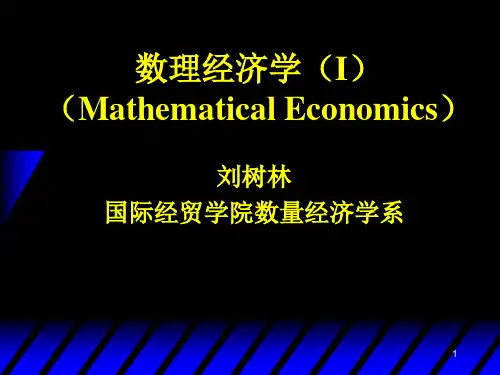


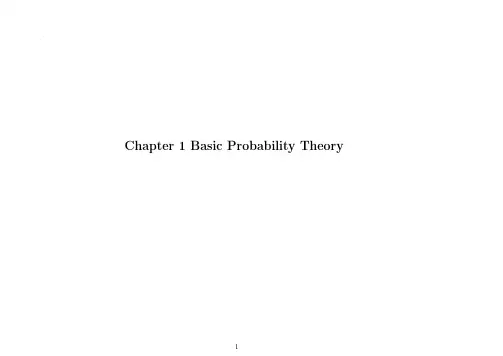
.Chapter1Basic Probability Theory•A random experiment is a process that generates well-defined outcomes. One and only one of the possible experimental outcomes will occur,but there is uncertainty associated with which one will occur.•Fundamental axioms of modern econometrics:–An economic system can be viewed as a random experiment governed by some probability distribution or probability law.–Any economic phenomena(often in form of data)can be viewed as an outcome of this random experiment.•Two essential elements of a random experiment:–The set of all possible outcomes—sample space.–The likelihood with which each outcome will occur—probability func-tion.•Definition:Sample Space.The possible outcomes of the random experiment are called basic outcomes,and the set of all basic outcomes is called the sample space,denoted by S.When an experiment is performed, the realization of the experiment is one outcome in the sample space.•Examples:Finite Sample Space.Experiment Sample SpaceToss a coin{Head,Tail}Roll a die{1,2,3,4,5,6}Play a football game{Win,Lose,Tie}•Example:Infinite Discrete Sample Space.Consider the number of accidents that occur at a given intersection within a month.The sample space is the set of all nonnegative integers{0,1,2,···}.•Example:Continuous Sample Space.When recording the lifetime of a light bulb,the outcome is the time until the bulb burns out.Therefore the sample space is the set of all nonnegative real number{t:t∈R,t≥0}.•Definition:Event.An event A is a subset of basic outcomes from the sample space S.The event A is said to occur if the random experiment gives rise to one of the constituent basic outcomes in A.That is,an event occurs if any of its basic outcomes has occurred.•Example:A die is rolled.Event A is defined as“number resulting is even”. Event B is”number resulting is4”.Then A={2,4,6}and B={4}.•Remarks:–The words”set”and”event”are interchangeable.–Basic outcome∈sample space,event⊂sample space.•Definition:Containment.The event A is contained in the event B, or B contains A,if every sample point of A is also a sample point of B. Whenever this is true,we will write A⊂B,or equivalently,B⊃A.•Definition:Equality.Two events A and B are said to be equal,A=B, if A⊂B and B⊂A.•Definition:Empty Set.The set containing no elements is called the empty set and is denoted by∅.The event corresponding to∅is called a null(impossible)event.•Definition:Complement.The complement of A,denoted by A c,is the set of basic outcomes of a random experiment belonging to S but not to A.•Definition:Union.The union of A and B,A∪B,is the set of all basic outcomes in S that belong to either A or B.The union of A and B occurs if and only if either A or B(or both)occurs.•Definition:Intersection.The intersection of A and B,denoted by A∩B or AB,is the set of basic outcomes in S that belong to both A and B.The intersection occurs if and only if both events A and B occur.Venn Diagram:Use circles(or other shapes)to denote sets(events).The inte-rior of the circle represents the elements of the set,while the exterior represents elements which are not in the set.Figure1:Venn Diagrams:(a)Complement,(b)Union,and(c)Intersection•Definition:Difference.The difference of A and B,denoted by A\B or A−B,is the set of basic outcomes in S that belong to A but not to B, i.e.A\B=A∩B c.The symmetric difference,A÷B,contains basic outcomes that belong to A or to B,but not to both of them.Figure2:Venn Diagrams:Symmetric Difference.1.3Review of Set Theory•Definition:Exclusiveness.If A and B have no common basic out-comes,they are called mutually exclusive(or disjoint).Their intersection is empty set,i.e.,A∩B=∅.•Definition:Collectively Exhaustive.Suppose A1,A2,···,A n are n events in the sample space S,where n is any positive integer.If∪n i=1A i=S, then these n events are said to be collectively exhaustive.•Definition:Partition.A class of events H={A1,A2,···,A n}formsa partition of the sample space S if these events satisfy(1)A i∩A j=∅for all i=j(mutually exclusive).(2)A1∪A2∪···∪A n=S(collectively exhaustive).Laws of Set Operations•Complementation(A c)c=A,∅C=S •CommutativityA∪B=B∪A,A∩B=B∩A.•AssociativityA∪(B∪C)=(A∪B)∪C,A∩(B∩C)=(A∩B)∩C.•Distributivity:A∩(B∪C)=(A∩B)∪(A∩C),A∪(B∩C)=(A∪B)∩(A∪C). More Generally,for n≥1,B∩(∪n i=1A i)=∪n i=1(B∩A i),B∪(∩n i=1A i)=∩n i=1(B∪A i).•De Morgan’s Laws:(A∪B)c=A c∩B c,(A∩B)c=A c∪B c. More Generally,for n≥1,(∪n i=1A i)c=∩n i=1(A c i),(∩n i=1A i)c=∪n i=1(A c i).Use Venn diagrams to check De Morgan’s Laws for the case of two events(A∪B)c=A c∩B c.Figure3:Validation of(A∪B)c=A c∩B c.Left panel:(A∪B)c;right panel:A c∩B c.•How to prove the general case of De Morgan’s Laws(n>2)(∪n i=1A i)c=∩n i=1(A c i).•Proof.x∈(∪n i=1A i)c⇔x/∈A i for any i=1,···,n⇔x∈A c i for all i=1,···,n⇔x∈∩n i=1(A c i).Hence,the equality holds.•Definition:Probability Function.Suppose a random experiment has a sample space S .The probability function P maps an event to a real number between 0and 1.It satisfies the following properties:(1)0≤P (A )≤1for any event A in B .(2)P (S )=1.(3)Countable Additivity :If countable number of events A 1,A 2,···∈B are mutually exclusive (pairwise disjoint),then P (∪∞i =1A i )=∑∞i =1P (A i ).•Definition:Countable Set.A set S is called countable if the set can be put into1-1correspondence with a subset of the natural numbers.•Remarks:–We can use a(finite or infinite)sequence to list all elements in a countable set.–Finite sets are countable.–The set of natural numbers,the set of integers,and the set of rational numbers are countable sets.–The set of all real numbers in interval(a,b),b>a,is uncountable.Properties of Probability Function:•P (Φ)=0.•P (A c )=1−P (A ).•If C 1,C 2,···are mutually exclusive and collectively exhaustive,thenP (A )=∞∑i =1P (A ∩C i ).•If A ⊂B ,P (A )≤P (B ).•Subadditivity :For events A i ,i =1,2,···,P (∪∞i =1A i )=∞∑i =1P (A i \∪i −1j =1A j )≤∞∑i =1P (A i ).•Theorem:For any n events A1,···,A n,P(∪n i=1A i)=∑i P(A i)−∑i1<i2P(A i1A i2)+∑i1<i2<i3P(A i1A i2A i3)+···+(−1)n+1P(A1A2···A n).•Proof by induction.–When n=2,the theorem is true.–Assume for n=k events,the theorem is true.–For n=k+1events,we haveP(∪k+1i=1A i)=P(A k+1)+P(∪k i=1A i)−P(∪k i=1(A i A k+1)).Apply the formula of n=k events to P(∪k i=1A i)and P(∪k i=1(A i A k+1)), we obtain the formula for n=k+1events.1.5Methods of Counting•For the so-called classical or logical interpretation of probability,we will assume that the sample space S contains afinite number N of outcomes and all of these outcomes are equally probable.•For every event A,P(A)=number of outcomes in AN.•How to determine the number of total outcomes in the space S and in various events in S?1.5Methods of Counting•We consider two important counting methods:permutation and combi-nation.•Fundamental Theorem of Counting.If a random experiment con-sists of k separate tasks,the i-th of which can be done in n i ways,i=1,···,k,then the entire job can be done in n1×n2×···×n k ways.•Example:Permutation.Suppose we will choose two letters from fourletters{A,B,C,D}in different orders,with each letter being used at mostonce each time.How many possible orders could we obtain?There are12ways:{AB,BA,AC,CA,AD,DA,BC,CB,BD,DB,CD,DC}.The word“ordered”means that AB and BA are distinct outcomes.Permutations•Problem:Suppose that there are k boxes arranged in row and there are n objects,where k≤n.We are going to choose k from the n objects tofill in the k boxes.How many possible different ordered sequences could you obtain?–First,one object is selected tofill in box1,there are n ways.–A second object is selected from the remaining n−1objects.Therefore, there are n−1ways tofill box2.–..–The last box(box k),there are n−(k−1)ways tofill it.•The total number of different ways tofill box1,2,···,k isn(n−1)···(n−(k−1))=n! (n−k)!.•The experiment is equal to selecting k objects out of the n objectsfirst, then arrange the selected k objects in a sequence.•Each different arrangement of the sequence is called a permutation.•The number of permutations of choosing k out of n,denoted by P k n,isP k n=n! (n−k)!.•Convention:0!=1.•Example:The Birthday Problem.What is the probability that at least two people in a group of k people(2<k≤365)will have the same birthday?–Let S={(x1,x2,···,x k)},x i represents the birthday of person i.How many outcomes in S?365k.–How many ways the k people can have different birthdays?P k365.–The probability that all k people will have different birthday is P k365/365k.–The probability that at least two people will have the same birthday is p=1−P k365/365k.–k=10,p=0.1169482;k=20,p=0.4114384,k=30,p=0.7063162, k=40,p=0.8912318,k=50,p=0.9703736;k=60,p=0.9941227.Combinations•Choosing a subset of k elements from a set of n distinct elements.•The order of the elements is irrelevant.For example,the subsets{a,b}and {b,a}are identical.•Each subset is called a combination.•The number of combinations of choosing k out of n is denoted by C k n.We haveC k n=the number of choosing k out of n with ordering the number of ordering k elements=P k n/k!=n!/k!(n−k)!.•Example:Combination.Suppose we will choose two letters from four letters{A,B,C,D}.Each letter is used at most once in each arrangement but now we are not concerned with their ordering.How many possible pairs could we have?There are six pairs:{A,B},{A,C},{A,D},{B,C},{B,D},{C,D}.•Example:A class contains15boys and30girls,and10students are to be selected at random for a special assignment.What is the probability that exactly3boys will be selected?–The number of combinations of10students out of45students is C1045.–The number of combinations of3boys out of15boys is C315.–The number of combinations of7girls out of30girls is C730.–Thus,p=C315C730/C1045.•C k n is also denoted by (nk).This is also called a binomial coefficientbecause of its appearance in the binomial theorem(x+y)n=n∑k=0(nk)x k y n−k.•Properties of the binomial coefficients–∑nk=0C k n=2n,∑nk=0(−1)k C k n=0.–∑ik=0C k n C i−kn=C i2n.–C k n+C k−1n=C k n+1.•Example:The Matching Problem.A person types n letters,types the corresponding addresses on n envelopes,and then places the n letters in the n envelopes in a random manner.What is the probability p n that at least one letter will be placed in the correct envelope?•ANS:–Let A i be the event that letter i,i=1,···,n,is placed in the correct envelope.We need to determine the value of P(∪n i=1A i).–Use formulaP(∪n i=1A i)=∑i P(A i)−∑i1<i2P(A i1A i2)+∑i1<i2<i3P(A i1A i2A i3)+···+(−1)n+1P(A1A2···A n).–∑i1<···<i kP(A i1···A ik)=C k n×(n−k)!/n!=1/k!.–P(∪n i=1A i)=1−12!+13!−···+(−1)n+11n!=n∑i=1(−1)i+11i!=−[n∑i=0(−1)i1i!−1]≈1−e−1≈0.632.1.6Conditional Probability•Different economic events are generally related to each other.Because of the connection,the occurrence of event B may affect or contain the information about the probability that event A will occur.•Example:Financial Contagion.A large drop of the price in one market can cause a large drop of the price in another market,given the speculations and reactions of market participants.•Definition:Conditional Probability.Let A and B be two events in(S,B,P).Then the conditional probability of event A given event B, denoted as P(A|B),is defined asP(A|B)=P(A∩B) P(B)provide that P(B)>0.•Properties of Conditional Probability:–P(A)=P(A|S).–P(A|B)=1−P(A c|B).–Multiplication RulesP(A∩B)=P(B)P(A|B)=P(A)P(B|A).•Example:Suppose two balls are to be selected,without replacement,from a box containing r red balls and b blue balls.What is the probability that thefirst is red and the second is blue?ANS:Let A={thefirst ball is red},B={the second ball is blue}.ThenP(A∩B)=P(A)P(B|A)=rr+b·br+b−1.•Theorem:Chain Rule.For any events A1,A2,···,A n,we haveP(A1A2···A n)=P(A1)P(A2|A1)P(A3|A1A2)···P(A n|A1···A n−1) provided P(A1···A n−1)>0.•Remark–P(A1···A n−1)>0implies P(A1)>0,P(A1A2)>0,···.•Theorem:Rule of Total Probability.Let{A i,i=1,2,···}be a partition(i.e.,mutually exclusive and collectively exhaustive)of S,P(A i)> 0for i≥1.For any event B in S,P(B)=∞∑i=1P(B|A i)P(A i).•Example:Suppose B1,B2,and B3are mutually exclusive.If P(B i)=1/3 and P(A|B i)=i/6for i=1,2,3.What is P(A)?(Hint:B1,B2,B3are also collectively exhaustive.)•Bayes’Theorem:P(B|A)=P(A|B)P(B)P(A).•Remarks:–We consider P(B)as the prior probability about the event B.–P(B|A)is posterior probability given that A has occurred.•Alternative Statement of Bayes’Theorem:Suppose E1,···,E n are n mutually exclusive and collectively exhaustive events in the sample space S.ThenP(E i|A)=P(A|E i)P(E i)P(A)=P(A|E i)P(E i)∑ni=1P(A|E i)P(E i).•Example:Auto-insurance Suppose an insurance company has three types of customers:high risk,medium risk and low risk.From the com-pany’s consumer database,it is known that25%of its customers are high risk,25%are medium risk,and50%are low risk.Also,the database shows that the probability that a customer has at least one accident in the current year is0.25for high risk,0.16for medium risk,and0.10for low risk.What is the probability that a new customer is high risk,given that he has had one accident during the current year?•ANS:Let H,M,L are the events that the customer is a high risk,medium risk or low risk customer.Let A be the event that the customer has had one accident during the current year.ThenP(H|A)=P(A|H)P(H)P(A|H)P(H)+P(A|M)P(M)+P(A|L)P(L).Given P(H)=0.25,P(M)=0.25,P(L)=0.50,P(A|H)=0.25, P(A|M)=0.16,P(A|L)=0.10,we haveP(H|A)=0.410.•Example:In a certain group of people the ratio of the number of men to the number of women is r.It is known that the incidence of color blindness among men is p,and the incidence of color blindness among women is p2. Suppose that the person that we randomly selected is color blind,what is the probability that the person is a man?•ANS:Let M and W denote the events“man selected”and“woman se-lected”,and D be the event“the selected person is color blind”.ThenP(M|D)=P(D|M)P(M)P(D|M)P(M)+P(D|W)P(W)=pr1+rpr1+r+p21+r=rr+p.•Example:In a TV game there are three curtains A,B,and C,of which two hide nothing while behind the third there is a Big Prize.The Big Prize is won if it is guessed correctly which curtain hides it.You choose one of the curtains,say A.Before curtain A is pulled to reveal what is behind it,the game host pulls one of the two other curtains,say B, and shows that there is nothing behind it.He then offers you the option to change your decision(from curtain A to curtain C).Should you stick to your original choice or change to C?•ANS:Let A,B,and C be the events“Big Prize is behind curtain A”(respectively,B and C).We can assume P(A)=P(B)=P(C)=1/3. Let B∗be the event“host shows that there is nothing behind curtain B”. ThenP(A|B∗)=P(B∗|A)P(A)P(B∗|A)P(A)+P(B∗|B)P(B)+P(B∗|C)P(C).–If the prize is behind curtain A,the host randomly pulls curtain B or curtain C,so P(B∗|A)=1/2.–If the prize is behind curtain B,P(B∗|B)=0.–If the prize is behind curtain C,P(B∗|C)=1.Therefore,P(A|B∗)=12×1312×13+0×13+1×13=1/3.Similarly,P(C|B∗)=2/3.•If two events A and B are unrelated.Then we expect that the information of B is irrelevant to predicting P(A).In other words,we expect that P(A|B)=P(A).•Definition:Independence.Two events A and B are said to be statis-tically independent if P(A∩B)=P(A)P(B).•Remarks:–By this definition,P(A|B)=P(A∩B)/P(B)=P(A)P(B)/P(B)=P(A).Similarly,we have P(B|A)=P(B).Therefore,the knowledge of B does not help in predicting A.–If P(A)=0,then any event B is independent of A.•Example:Random Walk Hypothesis(Fama1970).If a stock market is fully efficient,then the stock price P t will follow a random walk; that is,P t=P t−1+X t,where the stock price change{X t=P t−P t−1}is independent across different periods.•Example:Geometric Random Walk Hypothesis.The stock price {P t}is called a geometric random walk if X t=ln P t−ln P t−1is independent across different time periods.Note that X t≈P t−P t−1approximates theP t−1relative stock price change.•Example:Suppose two events A and B are mutually exclusive.If P(A)> 0and P(B)>0,can A and B be independent?•ANS:A and B are not independent becauseP(A∩B)=0=P(A)P(B).•Theorem:Let A and B be two independent events.Then(a)A and B c;(b)A c and B;(c)A c and B c are all independent.•Proof.(a)P(AB c)=P(A)−P(AB)=P(A)−P(A)P(B)=P(A)[1−P(B)]=P(A)P(B c),A andB c are independent.•Remark:Intuitively,A and B c should be independent.Because if not, we would be able to predict B c from A,and thus predict B.•Definition:Independence Among Several Events.Events A1,···,A nare(jointly)independent if,for every possible collection of events A i1,···,A iK,where K=2,···,n and i1<i2<···<i K∈{1,2,···,n},P(A i1∩···∩A iK)=P(A i1)···P(A iK).•Remark:We need to verify2n−1−n conditions.For example,three events A,B,and C are independent ifP(A∩B)=P(A)P(B),P(A∩C)=P(A)P(C),P(B∩C)=P(B)P(C),P(A∩B∩C)=P(A)P(B)P(C).•Remark:It is possible tofind that three events are mutually(pairwise) independent but not jointly independent.It is also possible tofind three events A,B,C that satisfy P(A∩B∩C)=P(A)P(B)P(C)but not independent.•Example:SupposeS={a,b,c,d}and each basic outcome is equally likely to occur.Let A1={a,b},A2= {b,c},and A3={a,c}.Then we haveP(A1)=P(A2)=P(A3)=12,P(A1A2)=P(A1A3)=P(A2A3)=14,butP(A1A2A3)=0=1 8 .•Example:Suppose S={a,b,c,d,e,f,g,h}and each basic outcome is equally likely to occur.Let A1={a,b,c,d},A2={a,b,c,d},and A3={a,e,f,g}.ThenP(A1)=P(A2)=P(A3)=1 2 ,P(A1A2A3)=1 8 ,butP(A1A2)=1/2=P(A1)P(A2).•Theorem:If the events A1,A2,···,A n are independent,the same is true for events B1,B2,···,B n,where for each i,the event B i stands for either A i or its complement A c i.•Theorem:If the events A1,A2,···,A n are independent,thenP(A1∪···∪A n)=1−{[1−P(A1)]···[1−P(A n)]}.•Example:Consider experiments1,2,···,n such that in each of them an event D may or not occur.Let P(D)=p for every experiment,and let A k be the event“D occurs at the k-th experiment”.•ANS:A1∪···∪A n is the event“D occurs at least once in the n experi-ments”.ThenP(A1∪···∪A n)=1−{[1−P(A1)]···[1−P(A n)]}=1−(1−p)n.。
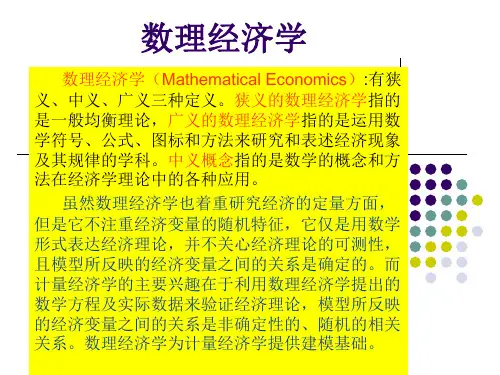
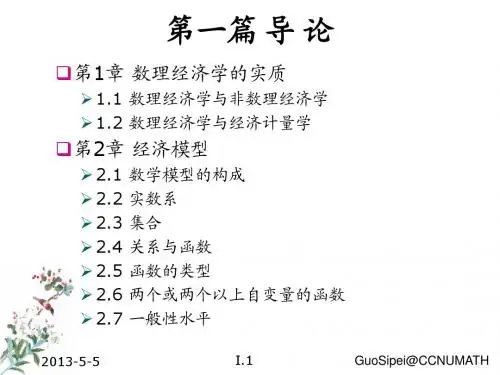

数理经济学
数理经济学是一门研究数量和经济行为的综合学科,它对数学、统计学和经济学的应用相结合。
它的出现开拓了经济学的发展范围,深入剖析经济存在的问题,提供有效的解决解决方案,并实施经济政策。
数理经济学主要通过定量分析及模型去研究社会经济现象和政策,比如微观经济,宏观经济,货币市场,国际经济等等。
数理经济学运用了数学、统计、技术分析和实验方法来建模经济各类问题和政策,推导出有效的经济分析结果以及经济政策可行性分析。
数理经济学还有助于更好地理解复杂的经济系统,比如,金融市场中各类金融资产价格的变化,这些价格变化受多种因素共同影响,既有宏观因素也有微观因素,数理经济学使分析师们能够深入分析相关问题,并利用概率模型来研究当前的经济形势和走势。
总而言之,数理经济学运用了数学、统计、技术分析和经济学的原理,以及实验和模型等,来研究经济现象。
它为经济研究和经济政策制定提供了有效的方法,这极大地推动了经济发展和改善了现实经济环境。
第1章习题答案1.什么是数理经济学?解:什么是数理经济学尚无统一的定义,以下是几种代表性的定义。
美国经济学家Kenneth J. Arrow(阿罗)等人在《数理经济学手册》一书中指出:数理经济学是包括数学概念和方法在经济学,特别是在经济理论中的各种应用。
Alpha C. Chiang(蒋中一)、Kevin Wainwright(凯尔文·温赖特)在《数理经济学的基本方法》一书中指出:数理经济学是一种经济分析方法,是经济学家利用数学符号描述经济问题,运用已知的数学定理进行推理的一种方法。
就分析的具体对象而言,它可以是微观或宏观经济理论,也可以是公共财政、城市经济学或其他学科方面的理论。
路甬祥、杜瑞芝分别在《现代科学技术大众百科—科技与社会卷》和《数学史辞典》指出:数理经济学是运用数学符号、数学方法和数学图形表述和论证经济现象及其相互依存关系的一门综合性边缘学科,研究经济活动中的数量关系并从中寻找规律。
杨小凯在《数理经济学基础》中指出:数理经济学主要是进行定性分析的理论经济学,它研究最优经济效果、利益协调和最优价格的确定这些经济学基本理论问题,为经济计量学、管理科学、经济控制论提供模型框架、结构和基础理论,它实在是经济学的基础之基础。
由以上定义可以看出:数理经济学主要是介绍数学方法如何应用到经济分析中,如经济问题如何用数学模型表示,一个变量的变化如何影响另一变量的变化等问题。
因此,数理经济学与其说是一门经济学分支学科,不如说它是一种经济学分析方法。
2.数理经济学是如何诞生的?简述其发展过程。
解:数理经济学的诞生和发展是数学在经济学中应用的过程,也是经济学发展的必然结果。
因为经济学家不仅仅要关心现实生活中的许多经济现象,更要对经济现象的数量,如价格、产量、收入、就业、失业、CPI、GDP等进行度量,要和数量打交道,便要研究数量之间的变化与关系,以此来把握经济运行规律,故数学就必然进入经济学的领域。
第1章数理经济学的性质●数理经济学(mathematical economics)⏹指采用数学符号描述经济问题,并运用已有的数学原理进行推理的分析方法及其体系。
11.1 数学与经济学1.2 数理经济模型1.3 最优化问题21.1 数学与经济学1.1.1 经济学的数学化1.1.2 数学之于经济学的意义1.1.3 经济学数学化的代价l31.1.1 经济学的数学化●20世纪30年代后,经济学开始数学化●今天,高等数学是从事学术研究的基本技能●经济学在总体上具备物理学研究的架构1.借助数学模型,提出理论假说,刻画经济事实2.概括观察结果,用实际数据(一般指统计数据)检验理论假说的真伪。
●数学在经济学中的应用1.理论研究(theoretical analysis )工具2.经验研究(empirical analysis)工具41.1.2 数学之于经济学的意义●建模是经济学家的首要工作●经济模型集中于探讨经济问题的核心方面●建模形式文字描述物理模型数学模型●理论研究采用文字描述、物理模型或运用数学符号,无实质差别●数学模型更便于演绎推理,并使表述更言简意赅5●数理模型的优势促使分析者在推理过程中做出明确假设揭示了直觉判断的局限性,有时能够挖掘出与直觉判断相悖的特例 便于交流61.1.3 经济学数学化的代价●让经济理论变得狭隘⏹经济理论变得更简单,逻辑性更强,数量更多⏹对数理模型进行统计检验逐渐成为标准的程序●一种批评:借助数学推导的理论是不现实的⏹理论在本质上是不现实的⏹“不现实”既适用于数理经济理论,也适用非数理性的经济理论⏹关于数理性的经济理论缺乏现实性的批评不是一种有效的批评71.2 数理经济模型1.2.1 超越几何学方法使我们能够处理n个变量的一般情形。
81.2.2 经济模型●经济模型的构成⏹经济主体:消费者、工人、厂商和政府等。
⏹经济环境:对经济主体产生影响,但又在主体的可控能力之外⏹选择(choices):反映主体对环境时的判断决策理性假设。
1Basic Mathematical Concepts 1.1Concave,quasi-concave and homogenous functionsGiven two sets X and Y ,if each element of X can be associated with an element of Y ,which we denote by f (x );then we say f is a function from X into Y ,denoted by f :X !Y:The sets X and Y are said to be the domain and range of f;respectively.A set X is convex if for any x;x 02X;tx +(1 t )x 02X for all t 2[0;1].(Note:there is no such a thing as concave set.)A function f :X !R ,where X is a convex set,is concave convex if,for any x;y 2X;and 1 0;f ( x +(1 )y ) f (x )+(1 )f (y )If f is twice continuously di¤erentiable,then it is concave if and only if the Hessian of f 0B @f 11(x ) f 1n (x ).........f n 1(x ) f nn (x )1C A is negative (positive)semi-de…nite for all x 2X (see below).A function f :R n +!R is quasiconcave if the upper contours sets of the function f x :f (x )>a g are convex sets for all value of a .A function f :R n +!R is quasiconconvex if f is quasi-concave.An alternative de…nition for quasiconcave function is that f is quasiconcave quasiconvex if and only if for any two distinct points x and x 0in the domain of f ,and for 0< <1,f (x ) f x 0 =)f x +(1 )x 0 f (x ) f (x 0) If f is twice continuously di¤erentiable,then it is quasi-concave if and only if the naturally ordered principal minor of the bordered Hessian of f 0B B B @0f 1(x ) f n (x )f 1(x )f 11(x ) f 1n (x )............f n (x )f n 1(x ) f nn (x )1C C C A has signs0f 1(x )f 2(x )f 1(x )f 11(x )f 12(x )f 2(x )f 21(x )f 22(x ) 0;:::; 0f 1(x ) f j (x )f 1(x )f 11(x ) f 1j (x )............f j (x )f j 1(x )f jj (x )0 0 if j is odd even for all j n:1A function f :R n +!R is homogeneous of degree k if f (t x )=t k f (x )for all t >0:Ineconomics,many useful functions are homogenous of degree 0or 1,e.g.the demand function of a consumer is homogeneous of degree zero in prices and income.Euler’s Theorem:Suppose f is a homogeneous function of degree k .Let x =t x .Di¤erenti-ating f (t x )=t k f (x )to get@f (t x )@t =nX i =1@f (t x )@x i @x i @t =kt k 1f (x )The equation holds for all t .In particular,the equation is true for t =1;n X i =1@f (x )@x i x i =kf (x ):Consider an application of the Euler Theorem.Let f (K;L )be a production function where K and L are capital and labor respectively.For constant returns to scale,k =1and assume the price of the output is equal to one.In a competitive market,the factor price is equal to the value of marginal product.The Euler theorem gives f (K;L )=@f @K K +@f @L L =rK +wL where r and w are the rental and wage,respectively.The total value of factor payment exactly exhausts the value of output.1.2Taylor SeriesIt will be convenient to examine the properties of the extrema of a function by approximating the function by a polynomial.Given a function f (x );we may approximate it by a polynomial at the point x 0:P (x )=a 0+a 1 x x 0 +a 2 x x 0 2+a 3 x x 0 3+The derivatives of the polynomial aredP (x )dx =a 1+2a 2 x x 0 +3a 3 x x 0 2+ d 2P (x )dx 2=2a 2+2 3a 3 x x 0 + ;etcIf f and P have the same value at x 0,then a 0=f (x 0):If f and P also have the same derivatives at x 0,then the coe¢cients a 1;a 2;:::can be solved and thereforef (x )=f x 0 + x x 0d f dx x 0 + x x 0 22d 2f dx 2 x 0 + x x 0 33!d 3f dx 3x 0 + This is called the Taylor series expansion of f at point x 0.2Taylor Theorem:Let f :X !R ,where X is an open subset of R and f is continuously di¤erentiable of order n +1.Assume x 02X:Then for every h =0,x 0+h 2X;there exists x 1=x 0+ h for some 2(0;1)such thatf x 0+h =f x 0 +h d f dx x 0 + +h n n !d n f dx n x 0 +h n +1n +1!d n +1f dx n +1 x 1 The Taylor theorem tell us that f can be approximated by a polynomial of degree n and h n +1n +1!d n +1f dx n +1 x1 is the error involved in using this approximation.The theorem can be extended to multi-variable functions in the following way.Consider a multi-variable function f and we ap-proximate it at x 0 x 01;:::;x 0n .Let y (t )=f x 01+th 1;:::;x 0n +th n where h 1;:::;h n might take arbitrary values so that any point in the domain can be reached.Approximate y at t =0y (t )=y (0)+t dy dt (0)+t 22d 2y dt 2(0)+ Note that when t =0,x =x 0.Moreover,y (0)=f x0 dy dt (0)=n X i =1@f @x i x 0 h i d 2y dt 2(0)=n X i =1n X j =1f ij x 0 h i h j...Thereforef x 0+t h f x 0 +t X f i x 0 h i +t 22n X i =1n X j =1f ij x 0 h i h j +higher order terms.1.3Quadratic FormConsider A =264a 11:::a 1n .........a n 1:::a nn 375and x =264x 1...x n 375:Then x 0A x =P n i =1P n j =1a ij x i x j is called a quadratic form.Note that the second-order term inthe Taylor series contains a quadratic form.The matrix A is(a )negative de…nite if x 0A x <0for all x =0:3(b )positive de…nite if x 0A x >0for all x =0:(c )negative semide…nite if 0 x 0A x for all x :(d )positive semide…nite if x 0A x 0for all x :Given a square matrix A;if we form a new matrix by eliminate k columns and the same numbered k rows of A ,the determinant of this submatrix is called the minor of A .The naturally ordered (principal)minor (NOPM)of A are a 11 a 11a 12a 21a 22 a 11a 12a 13a 21a 22a 23a 31a 32a 33 and so ing the naturally ordered minor,we can easily test whether a matrix is negative or positive de…nite.A matrix A is symmetric if a ij =a ji :A symmetric matrix A is(a )positive de…nite if and only if the naturally ordered principal minor are all positive.a 11>0 a 11a 12a 21a 22 >0 a 11a 12a 13a 21a 22a 23a 31a 32a 33 >0and so on.(b )negative de…nite if and only if the naturally ordered principal minor of order k have sign ( 1)k for k =1;:::;n:a 11<0 a 11a 12a 21a 22 >0 a 11a 12a 13a 21a 22a 23a 31a 32a 33<0and so on.For optimization problem with constraints,we only want x A x to have a de…nite sign for some set of restricted values of x .We say A is positive de…nite subject to bx =0if x A x >0for all x =0satisfying bx =0:The other de…nition are extended in a natural way.we have to check the bordered matrix.A n n symmetric matrix A bordered by a vector b is (c )positive de…nite subject to constraint bx =0if and only if the naturally ordered border-preserving principal minors are all negative. 0b 1b 2b 1a 11a 12b 2a 21a 22 <0, 0b 1b 2b 3b 1a 11a 12a 13b 2a 21a 22a 23b 3a 31a 32a 33<0and so on.(d )negative de…nite subject to constraint bx =0if and only if the naturally ordered border-preserving principal minors have sign ( 1)k for k =2;:::;n . 0b 1b 2b 1a 11a 12b 2a 21a 22 >0, 0b 1b 2b 3b 1a 11a 12a 13b 2a 21a 22a 23b 3a 31a 32a 33 <0and so on.42Static Optimization 2.1Unconstrained OptimizationWe want to investigate the necessary and su¢cient conditions for y =f (x 1;:::;x n )to have a maximum at some point.First Order Necessary Condition :Let x =(x 1;:::;x n )be an interior point in the domain of the function f .If x is a maximum,then by the Taylor theorem,f (x +t h )=f (x )+tX f i (x )h i +t 22n X i =1n X j =1f ij (x + t h )h i h j f (x )for some 2(0;1):Orf (x +t h ) f (x )t =X f i (x )h i +t 2n X i =1n X j =1f ij (x + t h )h i h j 0for any h 2R n .As t !0;f (x +t h ) f (x )t !P f i (x )h i 0and this is true for any h :In particular,for h 1>0and h 2=:::=h n =0;we have f 1(x ) 0in order to satisfy the inequalty.But forh 1<0and h 2=:::=h n =0,we must have f 1(x ) 0:This implies that f 1(x )=0:By the same token,this is true for all other …rst-order derivatives.The …rst order necessary conditions for y =f (x )to be a maximum isf i (x )=0for any i =1;:::;n:Note that when the extremum point is on the boundary of the domain,the …rst derivative needs not be zero.For example,f :R +!R such that f (x )=1 x:In this case the maximum point is zero while d f (0)dx = 1:We have a corner solution for this maximization problem.Second Order Su¢cient Condition :x =f (x 1;:::;x n )is a maximum iff i (x )=0for any i =1;:::;n:n X i =1n X j =1f ij (x )h i h j <0for all vectors h =0Proof:By the Taylor theorem,f (x +t h )=f (x )+tX f i (x )h i +t 22n X i =1n X j =1f ij (x + t h )h i h j If the …rst order condition is satis…ed,f (x +t h ) f (x )=t 22n X i =1n X j =1f ij (x + t h )h i h j <05for small t:So x is a local maximum.By the second order condition,the Hessian matrix of f is negative de…nite.A function y =f (x 1;:::;x n )has a stationary value at x ;i.e.@f @x (x )=0:Suppose the naturally ordered principal minors (NOPM)alternate in sign,i.e.f 11(x )<0; f 11(x )f 12(x )f 21(x )f 22(x ) >0;:::;( 1)j f 11(x ) f 1j (x )...f j 1(x ) f jj (x ) >0for all j =1;:::;n;then x is a local maximum point.If the NOPM are all positive,then xis a local minimum point.To see why the signs of the NOPM has this pattern,consider the two-variable case:y =f (x 1;x 2).Take total di¤erential:dy =f 1dx 1+f 2dx 2andd 2y =f 11(dx 1)2+2f 12dx 1dx 2+f 22(dx 2)2=f 11(dx 1)2+2f 12dx 1dx 2+f 212f 11(dx 2)2+f 22(dx 2)2 f 212f 11(dx 2)2=f 11 dx 1+f 12f 11dx 2 2+f 22f 11 f 212f 11(dx 2)2For a maximum,we have d 2y <0for all dx 1and dx 2;If f 11>0;we can choose dx 1=0and dx 2=0;we must have d 2y >0and get a contradiction.Thus f 11<0.If f 22f 11 f 212<0;then we choose dx 1= f 12f 11dx 2;again we have d 2y >0and a contradiction.Therefore,f 22f 11 f 212>0:Example 1:A pro…t maximizing …rm employs n factors to produce one good.The objective function is =pf (x 1;:::;x n )n X i =1w i x i where y =f (x 1;:::;x n )is the production function.The …rst order necessary conditions are:i =pf i w i =0i =1;:::;nThe su¢cient condition for a maximum is that the successive principal minors of[ ij ]=0B @pf 11:::pf 1n .........pf n 1:::pf nn1C A 6alternate in sign.Since p >0;this implies that thesuccessive naturally ordered principal minorsof the Hessian of f 264f 11:::f 1n .........f n 1:::f nn375alternate in sign.The second order condition is satis…ed for concave production function.2.2Constrained OptimizationFor optimization with equality constraints,the solution is usually found by using the Lagrange-multiplier method.The idea is to transform the constrained optimization problem into a form such that the …rst order conition for unconstrained optimization can be applied.A typical maximization problem take the following form.maximize y =f (x 1;:::;x n )subject tog (x 1;:::;x n )=0First Order Necessary Condition :At a local maximum x ;there is such thatL j (x )=f j (x )+ g j (x )=0;j =1;:::;n:where the variables is known as the Lagrange multiplier.Second Order Su¢cient Condition:A su¢cient condition for a maximum isL j (x ; )=f j (x )+ g j (x )=0;j =1;:::;n:and the matrixL xx 2664@2L @x 1@x 1@2L @x 1@x n .........@2L @x n @x 1 @2L @x n @x n 3775is negative de…nite subject to a linear constraint,i.e.h 0L xx h <0for all h satisfying @g @x 1h 1+ +@g @x nh n =0This can be shown by considering the Taylor series of LL (x +t h )=L (x )+t n X i =1L i (x )h i +t 22n X i =1n X j =1L ij (x + t h )h i h j L (x )7To fully understand the …rst order condition,you need to know some linear alegbra.See Silberberg and Suen The Structure of Economics for the details of the …rst order condition.The second order condition can be checked by considering the bordered Hessian matrix D 2L 266664@2L @ 2@2L @ @x 1 @2L @ @x n @2L @ @x 1@2L @x 1@x 1 @2L @x 1@x n ......@2L @ @x n @2L @x n @x 1 @2L @x n @x n377775Suppose that at x ;the …rst order condition is satis…ed.It can be shown that x is a local maximum point if 0@2L (x )@ @x 1@2L (x )@ @x 2@2L (x )@ @x 1@2L (x )@x 1@x 1@2L (x )@x 1@x 2@2L (x )@ @x 2@2L (x )@x 2@x 1@2L (x )@x 2@x 2 >0; 0@2L (x )@ @x 1@2L (x )@ @x 2@2L (x )@ @x 3@2L (x )@ @x 1@2L (x )@x 1@x 1@2L (x )@x 1@x 2@2L (x )@x 1@x 3@2L (x )@ @x 2@2L (x )@x 2@x 1@2L (x )@x 2@x 2@2L (x )@x 2@x 3@2L (x )@ @x 3@2L (x )@x 3@x 1@2L (x )@x 3@x 2@2L (x )@x 3@x 3 <0; etc:The NOPM of the bordered Hessian must alternate in sign.For a minimum,all the NOPM are negative.2.3Nonlinear ProgrammingIn many economic problems,we have to deal with inequality constraints rather than equality constraints.These problems can be analyzed by nonlinear programming method.max f (x )subject to g k (x ) 0,k =1;:::;m:De…ne the Lagrange function byL (x ; )=f (x )+m X k =1 k g k (x )The set of points satisfying all the constraints x :g k (x ) 0;k =1;:::;m is called the feasibleset.If g k (x )=0at a particular x in the feasible set,we say constraint k is binding;otherwise,we say constraint k is slack.The Lagrange function has a saddle point if there exists 0and x such that L (x ; ) L (x ; ) L (x ; )for all x and all 0:That is,L achieve a maximum in the x directions,and a minimum in the directions.Saddle Point Theorem :If L has a saddle point (x ; ),then f has a global maximum at x subject to g k (x ) 0,k =1;:::;m:8Proof .Since (x ; )is a saddle point,f (x )+m X k =1 kg k (x ) f (x)+m X k =1 k g k (x ) f (x )+m X k =1 k g k (x )From the second inequality,P m k =1 k g k (x ) P m k =1 k g k (x ):Suppose g k (x )<0for some k;then we can make k su¢ciently large,thereby making P m k =1 k g k (x )small enough to violate P m k =1 k g k (x ) P m k =1 k g k (x ):Hence g k (x ) 0for all k:Since k 0and g k (x ) 0for all k;P m k =1 k g k (x ) 0:But the saddle point property holds for all 0,thus it holds for =0;and thus P m k =1 k g k (x ) 0:Combining the last two inequalities to get P m k =1 k g k (x )=0.Substitute this equation into the …rst inequality of the saddle point condition.Thus f (x ) f (x )for all x satisfying g k (x ) 0,k =1;:::;m .In general,a maximum needs not be a saddle point.However,if f and all g k are concave,andthere exists an b xsuch that g k (b x )>0for all k (this condition is known as the Slater constraint quali…cation ),then the saddle point condition is also necessary for any point to be a maximum of the nonlinear programming problem.The necessity of maximum to be a saddle point under the Slater condition is …rst proven by Uzawa.As the proof is quite di¢cult,we will not show it here.If you are interested,you can …nd the proof in Silberberg and Wing.A condition analogous to the First-Order Condition for classical optimization can be derived from the saddle point condition if f and g k are all continuously di¤erentiable.We have the Kuhn-Tucker conditions .@L (x ; )@x i=0for all i k 0;g k (x ) 0;and k g k (x )=0for all k:The conditions k g k (x )=0for all k are called the complementary slackness conditions .The K-T conditions are useful in the search for a solution of non-linear programming problems.In general,the Kuhn-Tucker condition is not su¢cient for the saddle point condition.If f and g are concave functions,however,the K-T conditions imply that the Lagrange function has a saddle point.Theorem (i )Suppose all f;g k are di¤erentiable.If (x ; )is a saddle point of L ,it satis…es the Kuhn-Tucker conditions.(ii )Suppose f;g k are concave functions.If (x ; )it satis…es the Kuhn-Tucker conditions,it is a saddle point of L .(i )Since k 0,g k (x ) 0;and P m k =1 k g k (x )=0;we have k g k (x )=0for all k .Furthermore,as L (x ; ) L (x ; )for all x ,x is a global maximum point of L ( ; );thus @L (x ; )@x i =0for all i:(ii )If f and g are concave,then L is also concave in x and L (x ;)+@L (x ; )@x (x x ) L (x ; )9=0for all i,L(x ; ) L(x; ).Moreover,g k(x ) 0;implies P m k=1 k g k(x ) Since@L(x ; )@x i0for all 0.Thus P m k=1 k g k(x ) P m k=1 k g k(x )=0and L(x ; ) L(x ; ).Combining all the results above,we obtain the following result.Theorem Suppose all f;g k are di¤erentiable and concave and the Slater constraint quali…-cation holds.Then x is a maximum if and only if there exist 0such that(x ; )satis…es the Kuhn-Tucker condition.Therefore for concave programming,the K-T conditons are su¢cient for a global maximum. Moreover,when the Slater’s constraint quali…cation holds the K-T conditons are also necessary conditions for a global maximum.Example:Xiao Ming consumes candy c and fruit f and has a utility function u(c;f)=2ln c+ ln f:Suppose he can spend no more than30Yuan and the prices of candy and fruit are1Yuan and5Yuan respectively.However,his mother does not allow him to consume more than15unit10of candy.His problem can be formulated as the followingmax2ln c+ln fsubject toc+5f 30c 15The Lagrange function is2ln c+ln f+ 1(30 c 5f)+ 2(15 c)Then the Kuhn-Tucker conditions are2c 1 2=01f 5 1=01 0; 1(30 c 5f)=02 0; 2(15 c)=0>0;thus complementary slackness implies30 c 5f=0:If From the second equation, 1=15f2=0;then2c 15f=0or c=10f:Then30 15f=0and c=20and f=2:This violates the constraint c 15:Therefore, 2>0and by complementary slackness,c=15:Finally,use the budget constraint to obtain f=3.2.4Constraint Quali…cationRecall that for concave programming f;g k concave ;under the Slater constraint quali…cation, the Kuhn-Tucker condition is necessary for an optimum.(i.e.if the non-linear programming problem has an optimum,the optimum point must satisfy the Kuhn-Tucker condition)Is this also true for a problem with some non-concave constraint g k?Consider an example.max f(x1;x2)=x1s:t:g1(x1;x2)=x1 0;g2(x1;x2)=x2 0g3(x1;x2)=(1 x1)3 x2 011Here the third constraint is not concave and the Slater condition is satis…ed e.g.at(0:5;0:1).The Lagrangian function and the Kuhn-Tucker condition for this problem areL=x1+ (1 x1)3 x2 + 1x1+ 2x2@L@x1=1 3 (1 x1)2+ 1=0@L@x2= + 2=0(1 x1)3 x2 0; 0; (1 x1)3 x2 =0x1 0; 1 0;x1 1=0x2 0; 2 0;x2 2=0Obviously,the problem has a maximum point at(1;0):But for x1=1; 1=0by complementaryslackness.Then@L@x1=1 3 (1 1)2+0=1and the Kuhn-Tucker condition is violated.So forproblems with non-concave constraint functions,some other constraint quali…cation is needed tomake the Kuhn-Tucker condition a necessary condition.We consider a constraint quali…cation…rst used by Kuhn and Tucker.Intuitively the Kuhn-Tucker constraint quali…cation(KTCQ)islike this.If we move away from the optimal point x and do not want to reduce the values of the e¤ective constraints,then we must not move outside the feasible set.Formally,for any dxsatisfyingdg k(x )=@g k(x )@x1dx1+ +@g k(x )@x ndx n 0if g k(x )=0there exists a curve satisfying three properties:(1)the curve start at x ,(2)it is contained in the feasible set and(3)it is targent to the vector dx at x :Under KTCQ,it can be shown that the Kuhn-Tucker condition must hold at any local optimum.Since f and g are not concave,we can only look for a local optimum rather than a global optimum.Note that KTCQ fails to hold in the previous example.To see this,note that g1(1;0)=1;g2(1;0)=0;g3(1;0)=0;and thus only g2;g3are e¤ective constraints.Evaluate the gradients of g2and g3at the optimum(1;0):@g2 @x1(1;0)=0;@g2@x2(1;0)=1@g3 @x1(1;0)=0;@g3@x2(1;0)= 1We can choose(a;0)or( b;0)for dx for any a 0and b>0:Both vectors give@g k(x )@x1dx1+@g k(x ) @x2dx2=0;k=2;3:But the vector(a;0)is pointing away from the feasible set and doesnot satisfy KTCQ.Surprisingly,if we add one more constraint in this example,KTCQ may hold. For example,take g4(x)=2 2x1 x2 0:The feasible set remains intact and g4is a also12an e¤ective constraint at(1;0).But now@g4(1;0)@x1(a)+@g4(1;0)@x2(0)<0so that we do not need toconsider(a;0):Thus KTCQ holds and the Kuhn-Tucker condition holds at(1;0):See Chiang for details.2.5Quasi-concave ProgrammingThe assumption of concave functions sometimes may be too strong for some economic applica-tion.For example,if the production technology of a…rm exhibits variable returns to scale,the production function may not be concave.(For consumer theory,in many situations,preferences can be represented by concave utility function).Luckily,the theory of concave programming can be extended to problems with quasi-concave objective and constraint functions.This kind of problem is referred to as quasi-concave programming.For quasi-concave programming,if the constraint functions are concave and there exists an x 0such that g k(x)>0for all k,the Kuhn-Tucker condition is a necessary condition for an optimum.However,for quasi-concave programming problem,the Kuhn-Tucker condition may not be a su¢cient condition.In that case,the solution we get from the Kuhn-Tucker condition may turn out not to be an optimum point.The following example illustrates.max(x 1)3s:t:2 x 0;x 0:The Lagrangian function and the Kuhn-Tucker condition for this problem isL=(x 1)3+ 1(2 x)+ 2x@L@x=3(x 1)2 1+ 2=01 0;2 x 0; 1(2 x)=02 0;x 0; 2x=0Note that the constraint is linear so that the Kuhn-Tucker condition is a necessary condition.For this problem,x=2is a maximum.Thus at x=2;the Kuhn-Tucker condition holds.But in this problem,the Kuhn-Tucker condition is not su¢cient.In particular,at x=1;which is not a maximum,the Kuhn-Tucker condition holds.We would like to know when the Kuhn-Tucker condition is a su¢cient condition.The following condition can be used to check whether a solution of the Kuhn-Tucker condition is a maximum or not.Let x satisfy the Kuhn-Tucker condition. Suppose one of the following conditions hold1.There exist x with x i>0for all i and g k(x) 0for all k and@f@x i (x )=0for at least onei:2.The function f is twice continuously di¤erentiable in a neighorhood of x and@f@xi (x )=0for at least one i:3.The function f is concave.13Then x must be a maximum.Condition1is stronger than the condition you would see in Arrow and Enthoven("Quasi-concave Programming",Econometrica,October1961,pp.779-800.)but has a simplier form.Note that in the previous example@f@x (1)=0and@f@x(2)=3.Thecondition is satis…ed at x=2but not at x=1.For quasi-concave programming,the Slater condition can still be used to ensure the necessity of K-T condition for a maximum provided g k are concave for all k or@g k@x i=0for all e¤ective constraints at the maximum.A Summary of the relation between a maximum and the Kuhn-Tucker condition1.If the objective function is concave and the constraint is linear,then the K-T condition must hold at the maximum(necessity).Moreover,any point satisfying K-T is a maximum(su¢ciency).2.If both the objective and the constraint functions are concave,any point satisfying K-T condition must be a maximum.However,a maximum may not satisfy K-T.3.If both the objective function and constraints are concave,and the Slater condition holds, then any point satisfying K-T must be a maximum and a maximum must satisfy K-T.4.If KTCQ holds,any local maximum must satisfy K-T.However,some non-maximum point may also satisfy K-T.5.If the objective function is quasi-concave and the constraints are concave,and the Slater condition holds,the K-T condition must hold at the maximum.But some non-maximum point may also satisfy K-T.6.If both the objective and the constraint functions are quasi-concave,and condition1,2,or 3holds,any point satisfying K-T condition is a maximum.Application:Optimal Incentive SchemeConsider a simple model of a principal-agent relationship.The principal want to induce the agent to take some action that is costly to the agent.A typical example is manager-worker relation.The manager is often unable to observe the action of the worker but may be able to partially infer the action of the worker by observing the output.The manager’s problem is to design an incentive payment to the worker that induce the worker to take the best action from the viewpoint of the manager.Suppose that there are only two possible outputs x1and x2where x1<x2and there are only two possible actions,a and b;that can be taken by the worker.Actions a and b can be interpreted as shirking and working hard,respectively.The actions can in‡uence the probability of occurrence of x i,i=1;2.Let ia and ib be the probability that output level x i is observed when the worker take action a and b;respectively.Naturally,it is more likely to get a high output if the worker works hard,i.e. 2a< 2b and 1a> 1b The manager pay s i to the worker if x i is observed.The expected pro…t of the manager if the worker chooses action b isX i=1;2(x i s i) ibThe worker is assumed to have expected utility function of income u where u0>0;u00<0. The cost(in utility)of the actions are denoted by c a and c b;respectively.The manager wants14the worker to choose action b:To achieve this,the payment scheme must satisfy the following incentive-compatibility constraint.X i=1;2 ib u i(s i) c b X i=1;2 ia u i(s i) c aThe principal’s maximization problem ismaxs1;s2X i=1;2(x i s i) ibsubject to X i=1;2 ib u(s i) c b u 0X i=1;2 ib u(s i) c b X i=1;2 ia u(s i)+c a 0where u is the utility the worker can get elsewhere.The payment scheme must give a higher expected utility than u or else the worker will not be participating.This is called participation constraint.The Lagrangian functionL(x; ; )=X i=1;2(x i s i) ib+ 0@Xi=1;2ib u(s i) c b u1A+ 0@Xi=1;2( ib ia)u(s i) c b+c a1AWe can solve the problem using the Kuhn Tucker condition.@L@s i= ib+ ib u0(s i)+ ( ib ia)u0(s i)=0;i=1;2(1)0;X i=1;2 ib u(s i) c b u 0; 0@Xi=1;2ib u(s i) c b u1A=0;0;X i=1;2( ib ia)u(s i) c b+c a 0; 0@Xi=1;2( ib ia)u(s i) c b+c a1A=0Divide(1)by ib u0(s i),we get1u0(s i)= + 1 ia ib ;i=1;2(2)15Since 1a1b >1> 2a2b;we must have u0(s1) u0(s2):As u is strictly concave i.e.u00<0;s1 s2:Moreover, 1 1a 1b 0<1u0(s1):Thus >0:By complementary slackness,X i=1;2 ib u(s i) c b u=0:(3) There are two cases:Case1:c a c b(workaholic).X i=1;2( ib ia)u(s i) c b+c a=( 2b 2a)(u(s2) u(s1)) c b+c a>0By complementary slackness, =0:Then(2)becomes1u0(s1)= :This implies u0(s1)=u0(s2):By strict concavity of u,s1=s2.As >0and P i=1;2 ib u(s i) c b u=u(s1) c b u=0: Then we can solve for s1from the last equation.Case2:c a<c b:Suppose =0,then by the same argument as case1,s1=s2.Then P i=1;2( ib ia)u(s i) c b+c a=c a c b<0which is a contradiction and thus >0:By complementary slackness,X i=1;2( ib ia)u(s i) c b+c a=0(4)Finally,we can use equations(3)and(4)to solve for s1and s2.16。